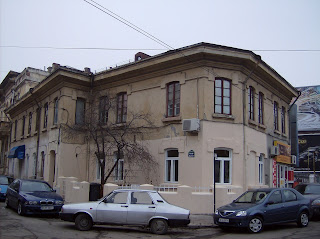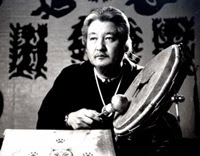
Casa Contelui Herosmonte, pe strada Visarion
L-am întâlnit prima oară prin anii cinzeci. Eram în şcoala primară, în clasa a doua sau a treia. O bună prietenă a mamei mă luase cu ea la cumpărături. Era seara. De abia ieşisem din blocul în care locuiam. Un domn înalt a trecut pe lângă noi şi s-a oprit să o salute pe prietena mamei mele. Se cunoşteau.
Pierre, domnul este inginerul Rădulescu-Hors
t, te rog să faci cunoş
tinţă cu el.
Domnul inginer Rădulescu-Horst a zâmbit cu multă amabilitate şi mi-a întins mâna, aplecându-se uşor.
Era ceva bizar în înfăţişarea lui. Nu părea deloc bucureştean. Mai curând scandinav. Dar nu orice fel de scandinav, nu, ar fi fost prea simplu.
Era extraordinar de rasat. Foarte înalt şi destul de slab, alură de mare senior. Chelia uriaşă nu îl reducea spre bonomie. Din contra, parcă îi sporea aerul seniorial. Nu puteai găsi nici cel mai mărunt semn de vulgaritate, nici cea mai mică sugestie de brutalitate. Era aristocratul perfect. Era de fapt neaşteptat de distins, într-un univers care părea cenuşiu şi amorf. Poate din cauza aceasta părea un pic bizar. Numai un pic?
Sigur, toate acestea nu aveam cum să mi le formulez atunci în minte. Aveam mai puţin de zece ani.
Peste vreo săptămână prietena mamei mi-a dăruit câteva creioane colorate.
Sunt de la domnul inginer Rădulescu-Horst,
cu ele nu ai cum să mai scrii urât.
Urât am scris în continuare, ba cu trecerea anilor chiar din ce în ce mai urât, dar asta este de acum altă poveste.
Pe domnul inginer Rădulescu-Horst l-am mai văzut de câteva ori în decursul anilor. Odată mă aflam într-un troleibuz pe strada Matei Voievod, domnul inginer ne-a depăşit lejer, la ghidonul unei biciclete. Purta un palton lung, capul era descoperit, deşi era destul de frig. Şi acelaşi zâmbet la limita dintre nobilitate şi bizarerie.
Îl mai vedeam din când în când la catedrala Sfântul Iosif; mă duceam destul de des duminica şi îl găseam acolo. Soseam de obicei foarte târziu, spre sfârşitul liturghiei, când credincioşii se îndreptau spre altar pentru a se împărtăşi. Îl remarcam imediat, aşezat disciplinat în rând, avansând uşor, cu acelaşi aer aristocratic, aflat firesc în vulg şi totodată departe de vulg.
Şi într-o duminică, aveam de acum vreo douăzeci şi cinci de ani, m-am apropiat de el. Tocmai ieşise din catedrală.
Am onoarea să vă salut domnule Horst, i-am zis.
Desigur nu vă mai amintiţi de mine. Cu mulţi ani în urmă doamna Paranici m-a prezentat dumneavoastra.
Oh, a răspuns el,
ce plăcere să vă revăd! Ce mai face doamna Paranici, nu am mai văzut-o de mult.
A murit acum câţiva ani, i-am zis.
Vai ce rău îmi pare! Nu am ştiut. Dar cum s-a întâmplat?
I-am vorbit despre suferinţa care o răpusese. Mă asculta atent, întristat.
Dupa câteva clipe m-a întrebat,
dar dumneavoastră ce mai faceţi?
Am terminat Politehnica de puţină vreme, lucrez ca inginer. Ma bucur mult să vă revăd, domnule Horst.
Să ştiţi, mi-a spus el zâmbind,
mi-am reluat vechiul meu nume, mă cheamă din nou Herosmonte.
Am încercat să îmi ascund uluiala. După cum vedeţi, pe Rădulescu îl lăsasem la o parte, dar să renunţ şi la Horst era de acum un şoc.
Herosmonte? O clipă m-am gândit dacă sub bizareria lui nu se ascundea un oarecare dram de ţăcăneală. Mă bucur mult că nu am cedat acestui gând, ci am lăsat lucrurile să curgă în voia lor.
Pentru că era într-adevăr vorba de Contele Herosmonte, prieten pe vremuri cu Prinţul Nicolae.
Însă asta aveam să o aflu un pic mai târziu.
Ce vârstă să fi avut? Singurul răspuns pe care îl găseam era că avea aceeaşi vârstă pe care o avusese cu mai mult de douăzeci de ani în urmă. Ca şi atunci, un bărbat trecut de vârsta a doua, dar încă nemarcat de bătrâneţe. Mă întrebam dacă fusese vreodată mai tânăr!
Există oameni distinşi care te complexează. Nu era cazul lui. Făcea parte (aveam să îmi dau tot mai bine seama mai târziu) dintr-o categorie foarte specială: cei care rămân tot timpul distinşi fără să te stingherească. Distanţa dintre tine şi ei există în mod natural, dar nu este o barieră.
Monseniorul Bolonjek, vreme de câţiva ani nunţiu apostolic la Bucuresti, avea să mă mai impresioneze prin clasa lui uriaşă. Îmi amintesc cum a intrat într-o seară în Biserica Italiană şi toata lumea a amuţit, în timp ce nunţiul înainta cu măreţie spre altar. Aveam în faţa mea un principe al bisericii!
Distincţia nunţiului era totuşi diferită. Simţeai distanţa.
Să mă întorc la Contele Herosmonte. De unde venea oare senzaţia de bizar? Poate accentul? Româna lui nu avea cusur, dar accentul era al unui om născut pe alte meleaguri.
Poate însă că nu accentul era ciudat. Altceva mai curând: lipsa oricărui semn de agresivitate, de brutalitate potenţială. În general lipsa aceasta ar fi fost stânjenitoare, te-ar fi condus la gândul unei lipse de virilitate, dar în cazul lui nu ăsta era gândul. Era mai curând vorba de o civilitate absolut naturală, care copleşea orice altă dimensiune. Şi tocmai lucrul acesta îi dădea un aer aflat undeva între farmec şi bizar. Pur şi simplu părea ireal.
Era oare real? Un conte străbătând anii grei ai comunismului, mereu egal cu el însuşi? Poate memoria copilăriei de acum îndepărtată îmi juca o festă. Poate că eram obosit şi vedeam o plăsmuire care avea să se topească în soarele amiezii.
Am închis ochii şi i-am deschis imediat. Era încă acolo în faţa mea şi zâmbea usor.
Mi-ar face plăcere să îmi faceţi o vizită, locuiesc împreună cu mătuşa mea.
Casa contelui se afla acolo unde începe strada Visarion. Pe vremea aceea colţul era cu strada Nicolae Iorga. Pentru că pe atunci Nicolae Iorga începea în Piaţa Romană, trecea pe lângă Visarion şi apoi o cotea la dreapta, spre celebrul sediu al miliţiei unde se dădeau paşapoartele.
Colţul cu Visarion avea să înfrunte anii, însă strada Nicolae Iorga a dispărut de acolo între timp, făcând loc noii artere căreia bucureştenii i-au găsit imediat un nume pe măsură, bazat pe cele două locuri de interes public aflate la capete, în Piaţa Romană şi pe Calea Griviţei.
Contele mă aştepta în fata casei. M-a condus pe scară spre mansardă. Casa fusese bine înteles naţionalizată, iar contele fusese mutat de autoritatea locativă în odăile de pe vremuri ale servitorilor. Noroc că odăile acelea erau foarte mari - contele fusese un generos şi se gândise la trebuinţele servitorilor lui atunci când construise casa.
Mobila era de mare rafinament, dar era puţină: o masă, scaune, vreo două comode. Pe vremuri fusese fireşte o sufragerie întreagă, însă anii de comunism erau grei, iar contele nu fusese angajat decât în munci necalificate şi extrem de prost plătite, aşa încât covoarele, tablourile, marea parte a mobilei fuseseră vândute, rând pe rând.
Contele suportase cu stoicism. Din ce îmi povestea, cel mai mult părea să fi fost îngrozit de lipsa de gust. Casa îi fusese naţionalizată, fusese dat afară şi mutat la mansardă în odăile servitorilor, ei bine, era indignat că noii chiriaşi zugrăviseră scările într-o paletă de culori detestabilă.
Mi-a povestit multe în seara aceea, atât de multe încât amintirile aveau să se amestece şi să devină tot mai confuze, dupa trecerea atâtor ani.
Familia din care se trăgea avea două ramuri principale, în Suedia şi Germania (Horst părea să fie numele german al familiei). Însă membri ai familiei Herosmonte existau şi în alte părţi ale Europei. Contele fusese adus in România când era mic. Numele de Rădulescu cred că îl primise de la tatăl adoptiv, dar nu aş jura că memoria nu îmi joacă vreun renghi.
Fusese invitat prin anii treizeci la o recepţie organizată pe insula Spitzbergen de către regele Norvegiei. Amintirea acestei recepţii a revenit de câteva ori în discuţia noastră. Contele povestea superb şi avea mai ales darul să scoată la iveală amănunte pline de culoare care te făceau să te transpui în poveste. Îl ascultam şi parcă îl vedeam îmbrăcat în frac, coborând de pe vapor şi întâmpinat pe ţărmul insulei de familia regală norvegiană.
M-a servit cu biscuiţi şi cu cafea, în ceşti micuţe de porţelan de Meissen. Continua să povestească.
Fusese foarte apropiat de Prinţul Nicolae. Zâmbeam unui gând, aşadar fusese şi el tânăr şi năzdrăvan? Avusese pasiunea automobilelor şi a vitezei? Mi-am amintit brusc de o fotografie pe care o văzusem de mult. Doamna Paranici, prietena mamei mele, fusese înainte de război administratoarea unuia din marile hoteluri din Sinaia. În fotografie apărea alături de conte şi de soţul ei, la Cota 1400. Fotografia era făcută prin anii treizeci. Ei bine, contele arăta la fel! Trebuia să admit că nu fusese niciodată tânăr, nu aveam alta explicaţie.
Fusese căsătorit de mult, însă pentru foarte puţin timp, soţia lui murise după numai câţiva ani. Rămăsese singur, amintirea ei era prea puternică, chiar după amar de vreme.
Savuram cafeaua şi îl ascultam.
Călătorise mult şi văzuse marile muzee ale Europei. Avusese posbilitatea să stăruie în câte un muzeu ore în şir, zi dupa zi.
Tocmai citisem o carte superbă a lui Fromentin,
Maitres d'autrefois, o găsisem într-un mic anticariat care era pe lângă cinematograful Scala. Visam să ajung şi eu să văd pânzele maeştrilor olandezi, iar Contele îmi povestea despre ce văzuse prin Rijksmuseum şi prin Zwinger, prin Luvru şi prin Alte Pinakothek. De la olandezi a trecut apoi la veneţieni.
Am terminat de băut cafeaua, contele s-a ridicat şi a deschis un sertar. A scos o carte.
Vorbeam de Giorgione şi de Tizian. Iată o carte publicată la Veneţia pe la anul 1700. Vă rog să o răsfoiţi. Există în carte o imagine a lui Mihai Viteazul.
Mătuşa lui a intrat în sufragerie. Avea o sută de ani. Micşorată de vârstă, nu mai auzea deloc. Contele i se adresa făcându-şi mâinile pâlnie la urechea ei. Era un pic caraghios, cum îşi aduna palmele în pâlnie, părea fâlfâitul aripilor unui cocostârc.
Mătuşa vorbea româneşte uşor cântat, cu un accent italienesc. Mi-a pus câteva întrebări, iar contele a răspuns în locul meu. A luat apoi cartea publicată la Veneţia şi s-a adâncit în lectura ei, fără să ne mai ia în seamă.
Aveam să ajung peste mulţi ani la Dresda, la Zwinger. Când am văzut lucrarea lui Vermeer,
Brieflesendes Mädchen, am tresărit. Mi s-a părut că Herosmonte se afla lângă mine, zâmbind. Îmi vorbise în seara aceea de demult despre pânza lui Vermeer de la Zwinger, aşa cum îmi vorbise şi despre sala cu picturi de Rembrandt.
Trecuse de acum amar de vreme din seara în care îl vizitasem, el avea însă aceeaşi vârstă. Am închis ochii, i-am deschis după o clipă. Contele dispăruse. Am închis ochii din nou, am privit în oglindă şi mi-am dat seama că anii lăsaseră de fapt urme adânci.
(Bucureşti)Labels: Paranici
























